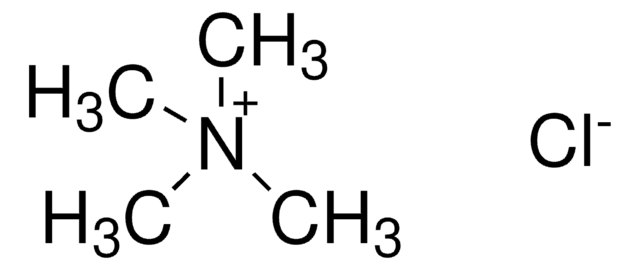T3038
Trizma®-Hydrochlorid -Lösung
1 M, BioReagent, for molecular biology
Synonym(e):
Tris-Hydrochlorid-Lösung
About This Item
Empfohlene Produkte
Qualität
for molecular biology
for molecular biology
Qualitätsniveau
Sterilität
0.2 μm filtered
Produktlinie
BioReagent
Form
solution
Konzentration
1 M
Verunreinigungen
DNase, RNase, NICKase and protease, none detected
pH-Wert
8.0
Anwendung(en)
agriculture
SMILES String
Cl.NC(CO)(CO)CO
InChI
1S/C4H11NO3.ClH/c5-4(1-6,2-7)3-8;/h6-8H,1-3,5H2;1H
InChIKey
QKNYBSVHEMOAJP-UHFFFAOYSA-N
Suchen Sie nach ähnlichen Produkten? Aufrufen Leitfaden zum Produktvergleich
Allgemeine Beschreibung
Anwendung
- Als Puffer für die 2-D-Elektrophorese von Fibroblastenzellen der Ratte.
- Als Puffer für die schnelle Isolierung von Pflanzen-DNA mit hohem molekularem Gewicht (Länge von mindestens 50.000 Basenpaaren).
- Selektive Immunpräzipitation Biotin-markierter DNA mit Antibiotin-IgG und Staphylococcus sp.
Verwenden Sie für präzise Anwendungen ein sorgfältig kalibriertes pH-Messgerät mit einer Glas/Kalomel-Kombielektrode.
Sonstige Hinweise
Rechtliche Hinweise
Lagerklassenschlüssel
10 - Combustible liquids
WGK
WGK 2
Flammpunkt (°F)
Not applicable
Flammpunkt (°C)
Not applicable
Persönliche Schutzausrüstung
Eyeshields, Gloves, type ABEK (EN14387) respirator filter
Analysenzertifikate (COA)
Suchen Sie nach Analysenzertifikate (COA), indem Sie die Lot-/Chargennummer des Produkts eingeben. Lot- und Chargennummern sind auf dem Produktetikett hinter den Wörtern ‘Lot’ oder ‘Batch’ (Lot oder Charge) zu finden.
Besitzen Sie dieses Produkt bereits?
In der Dokumentenbibliothek finden Sie die Dokumentation zu den Produkten, die Sie kürzlich erworben haben.
Kunden haben sich ebenfalls angesehen
Unser Team von Wissenschaftlern verfügt über Erfahrung in allen Forschungsbereichen einschließlich Life Science, Materialwissenschaften, chemischer Synthese, Chromatographie, Analytik und vielen mehr..
Setzen Sie sich mit dem technischen Dienst in Verbindung.










